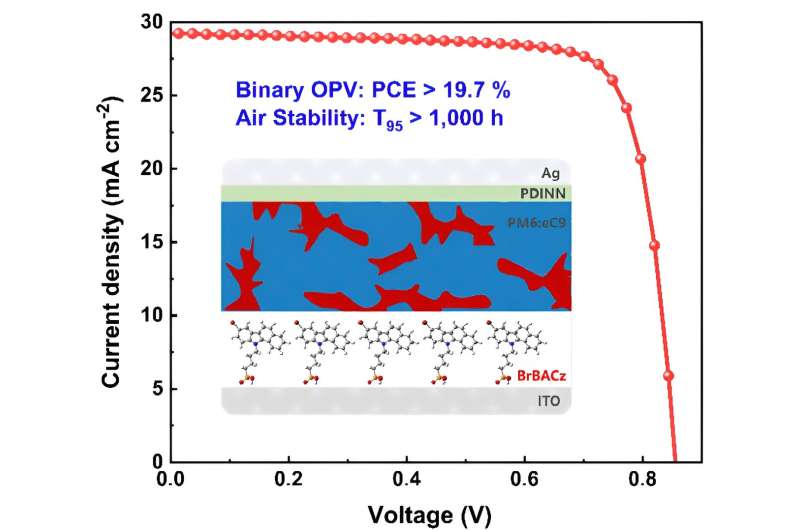This article has been reviewed according to Science X's editorial process and policies. Editors have highlighted the following attributes while ensuring the content's credibility:
fact-checked
peer-reviewed publication
trusted source
proofread
Researchers set new efficiency record for stable binary organic solar cells

A research group led by Prof. Ge Ziyi from the Ningbo Institute of Materials Technology and Engineering (NIMTE) of the Chinese Academy of Sciences has developed two self-assembled molecules (SAMs) with large dipole moments and employed them as hole-transporting layers (HTLs) in binary organic solar cells (OSCs), achieving highly efficient and stable binary OSCs with a record power conversion efficiency (PCE) of up to 19.70%.
Their work is published in Angewandte Chemie International Edition.
OSCs have attracted great attention in the field of organic electronic devices due to their advantages of light weight, good mechanical flexibility and translucency. The development of new materials and optimization of the fabrication process have contributed to the rapid improvement in the PCE of OSCs, which has exceeded 19%.
As a widely used hole transporting material for high efficiency OSCs, PEDOT:PSS imparts relatively low stability to OSCs due to its hydrophilicity and strong acidity. Therefore, achieving a balance between efficiency and stability in conventional OSCs still remains a challenge.
To address this issue, the researchers designed and synthesized two asymmetric SAMs with asymmetric backbone, namely BrCz and BrBACz. The two SAMs served as HTLs in binary OSCs based on the well-known system of PM6:Y6, PM6:eC9, PM6:L8-BO, and D18:eC9, respectively.
Compared with conventional PEDOT:PSS-controlled OSCs, the BrCz-controlled and BrBACz-controlled OSCs exhibited higher transmittance, deeper work function, and lower surface energy, thus realizing enhanced hole extraction, increased hole mobility, decreased interface resistance, and reduced carrier recombination.
The BrBACz-based OSC achieved a record high PCE of 19.70% with a remarkable current density of 29.20 mA cm-2 and a circuit voltage of 0.856 V, which is the highest value reported to date for binary OSCs.
When exposed to ambient air (40 ± 5% humidity) and continuous illumination for 1,036 hours, the BrBACz-controlled device can maintain up to 95.0% of its initial efficiency, which is the best air stability for the conventional OSCs.
In addition, the BrBACz-controlled device also plays a remarkable role in other well-known binary systems, such as PM6:Y6, PM6:L8-BO and D18:eC9, demonstrating its excellent generality.
This work may shed light on the future development and application of highly efficient and stable OSCs through rational molecular structure design.
More information: Xueliang Yu et al, Self‐Assembled Molecules with Asymmetric Backbone for Highly Stable Binary Organic Solar Cells with 19.7 % Efficiency, Angewandte Chemie International Edition (2024). DOI: 10.1002/anie.202401518


















